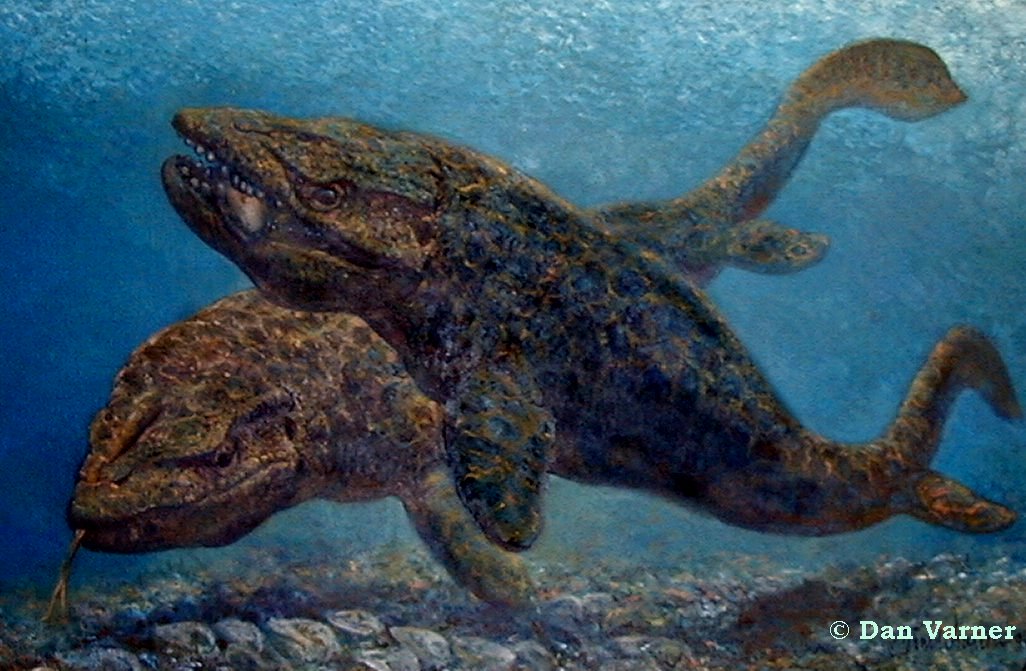 |
Globidens dakotensis - A Rare, Shell Crushing
Mosasaur from the Pierre Shale (Late Cretaceous) of Western Kansas
Copyright © 2000-2010 by Mike Everhart
Updated 06/17/2010
LEFT: "Globidens feeding on
clams" -Copyright © Dan Varner; used with permission of Dan Varner |
Referemce:
Everhart, M.J. 2008. Rare occurrence of a Globidens
sp. (Reptilia; Mosasauridae) dentary in the Sharon Springs Member of the Pierre Shale
(Middle Campanian) of Western Kansas. p. 23-29 in Farley G. H. and Choate, J.R.
(eds.), Unlocking the Unknown; Papers Honoring Dr. Richard Zakrzewski, , Fort Hays
Studies, Special Issue No. 2, 153 p., Fort Hays State University, Hays, KS.
Also, Jim Martin, South Dakota School of Mines and Technology, has
described a third species of Globidens from the DeGrey Member of the
Pierre Shale in central South Dakota. The new species, Globidens schurmanni nov.
sp. (Martin, 2007) is also the most complete (and youngest) known specimen, and includes
the skull, most of the vertebral column and partial limbs. In his comparison of known
specimens, Martin interpreted the Kansas dentary as G. dakotensis.
Martin, J. E. 2007. A new species
of the durophagous mosasaur, Globidens (Squamata: Mosasauridae) from the Late
Cretaceous Pierre Shale Group of central South Dakota, USA. Pages 167-176 in Martin, J. E.
and Parris D. C. (eds.), The Geology and
Paleontology of the Late Cretaceous Marine Deposits of the Dakotas. Geological Society of
America, Special Paper 427. Also,
just published (2010): Polcyn,
M.J., Jacobs, L.L., Schulp, A.S. and Mateus, O. 2010. The North African
Mosasaur Globidens phosphaticus from the Maastrichtian of Angola. Historical
Biology 22(1–3):175-185. |
Globidens is a highly derived genus of mosasaurs (Bell, 1997;
Bell and Polcyn, 2005) that reached cosmopolitan (world-wide) distribution during
Campanian and Maastrichtian time. Globidens remains typically consist
only of isolated
specimens of the characteristically round teeth.
The earliest known tooth attributable to a Globidens-type mosasaur was
discovered near Maastricht in the Netherlands and figured
by Faujas de Saint-Fond (1799, pl. 18, fig. 5). Another species, G. fraasi,
was described by Dollo (1913) from a right dentary collected near Maastricht in the
Netherlands. The teeth, however, were laterally compressed and distinctly different from Globidens,
and Dollo (1924) subsequently changed the genus name to Compressidens. However,
that name was pre-occupied and was revised to Carinodens by Thurmond (1969). Erica von Huene (1935) also described and figured a Globidens-like tooth
(G. timorensis) from East Timor in the East Indies.
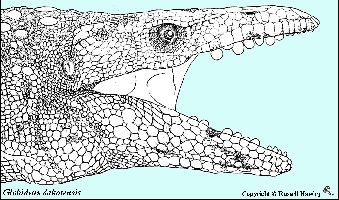 |
LEFT: A view of the head of Globidens dakotensis adapted from
Russell Hawley's pen and ink drawing. Prior to Martin (2007 - above), only 2
species had been described on the basis of skeletal material (G. alabamaensis
Gilmore, 1912 and G. alabamaensis Russell, 1975). However, dentarys are not present
with either of these two holotype specimens. |
In early 1995, Pete Bussen, a retired rancher and experienced paleontologist from
Wallace, Kansas, was prospecting for fossils in the Sharon Springs member of the Pierre
Shale near McAllaster Buttes, Logan County, Kansas. The dark gray shale exposure is about
a mile north of the locality where, in 1867, Dr. Theophilus H. Turner found and collected
what eventually became E. D. Cope's infamous and professionally embarrassing "head-on-the-wrong-end" Elasmosaurus platyurus
(Cope, 1868) plesiosaur.
The land that Pete now walked on had already produced the remains of a large
plesiosaur, several mosasaurs and a concretion filled with Baculites. As he moved
along the side of a steep gully, Pete noticed a large chunk of bone protruding from the
shale. By its general appearance, it appeared to be the lower jaw (dentary) of a mosasaur
but something was wrong with the teeth. Instead of being sharp, conical spikes for seizing
and tearing flesh, the teeth were round and bulbous. The only mosasaurs that he knew of
that had bulbous or globular teeth were a rare and unusual genus called Globidens.
The genus had never been collected in Kansas. Pete collected the large
piece of the jaw that was exposed, but noted that another piece remained buried
deeper in the shale.
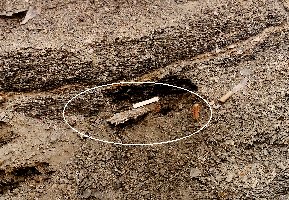 |
LEFT: When we returned to the site in April, 1995,
I placed the posterior portion of the dentary back into the exposure where
it fit perfectly with the piece that was still in the shale. I dug out the
anterior end of the dentary, but was disappointed not to see any other
visible remains. One thing that I noted immediately was that the teeth on
anterior of the dentary were shaped differently... more like rounded pegs,
than "marbles."
RIGHT: I enlarged the excavation but didn't locate any additional
remains. If they had been there originally, they may have eroded out long
ago, washed down the gully and lost. |
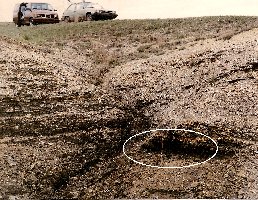 |
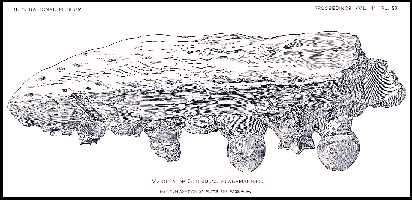 |
Plate 39 from Gilmore (1912): Lateral view of the left maxilla of Globidens
alabamaensis (Type specimen) in the United States National Museum (USNM 6527). |
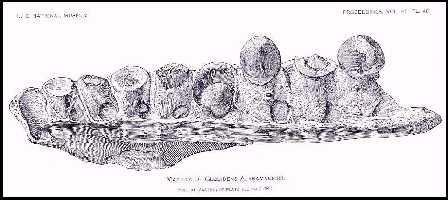 |
Plate 40 from Gilmore (1912): Oblique, medial view of dental
border of the left maxilla of Globidens alabamaensis (USNM 6527. |
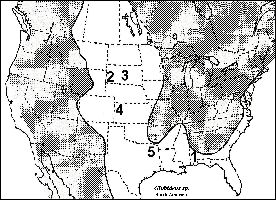 |
Although the isolated, round teeth had been found in many marine
deposits around the world, the first Globidens to be described (G.
alabamaensis, Gilmore, 1912) was found in the Mooreville Chalk of Alabama. Another
species, Globidens dakotensis (Russell, 1975), was discovered in the Pierre Shale
of South Dakota. A third, and very complete Globidens skeleton (including stomach
contents) was found in 1993 in South
Dakota but has only recently been prepared and described. LEFT:
Map of North America during the Late Cretaceous (Campanian) showing approximate localities
of Globidens specimens: 1) Holotype of Globidens alabamaensis, Mooreville Chalk, central
Alabama; 2) Holotype of G. dakotensis, Sharon
Springs Member, Pierre Shale, western South Dakota; 3) SDSMT specimen (Globidens
schurmanni nov. sp.) from the DeGrey Member of the Pierre Shale, central South
Dakota; 4) FHSM VP-13828, Sharon Springs Member, Pierre Shale, western Kansas; 5)
Undescribed Globidens material from the Ozan Formation, east
Texas. (Base map adapted from Carpenter, 1990). |
Pete Bussen realized that he had just found the first evidence that Globidens
had lived in the Western Interior Sea that covered Kansas millions of years ago. Looking
around, he scanned the area for other evidence but found only a few small bone scraps.
Thinking that the jaw represented a piece of a still buried and hopefully more
complete fossil, Pete called me and offered me the specimen to dig. When we returned to
the site later in the spring, however, the only piece to be found was the distal end of
the lower jaw, containing four peg-like teeth. After I removed several cubic yards of
shale to make sure that nothing else remained, I concluded that the rest of the fossil had
either eroded out years ago or that the jaw was all that had been preserved at that
location.
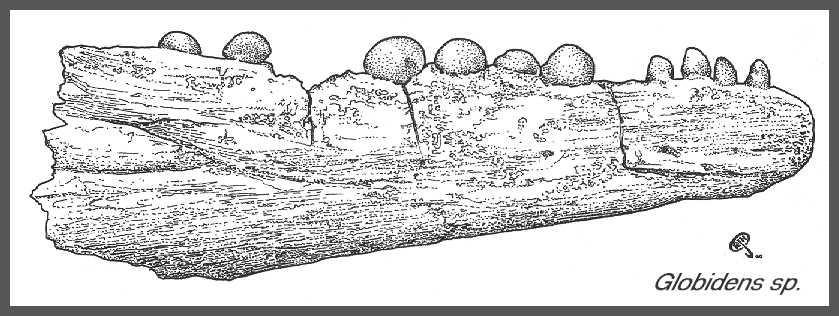
Drawing by Russell Hawley, ©
Copyright 2000 by Russell Hawley
When the jaw was cleaned and examined, there were a total of 10 teeth, and
empty sockets for three others. The largest of the globular teeth was 3 cm (slightly over
an inch) in diameter. The front four teeth differed from the globular back teeth and were
shaped more like rounded pegs than marbles. The nearly 14 inch long dentary was the front
half of the mosasaur’s lower jaw. It came from a jaw that would have been between 24
and 30 inches in length. Since the lower jaw in mosasaurs approximates the length of the
skull, the skull of this Globidens would have been 2 to 2 1/2 feet in length.
This, in turn, would have scaled up to an animal that would have been about 20 feet in
length.
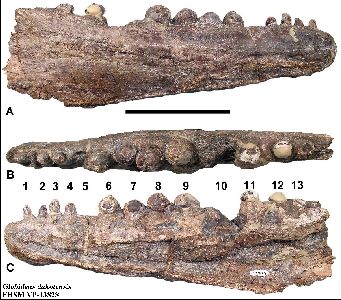 |
LEFT: The right dentary of the Kansas specimen of Globidens dakotensis
(FHSM VP-13828) in lateral, dorsal, occlusal and medial views. Note the differences
in shape between the anterior, peg-like teeth and the more posterior ball-like teeth. Numbers
represent tooth positions. The large areas between teeth 4 and 6, and 9 and 11
indicate that the teeth in those alveoli had fallen out before preservation. In case of
tooth #10, exostitial bone growth around the alveolus indicates some sort of
a bone infection
prior to the death of the mosasaur. (Scale =10 cm) |
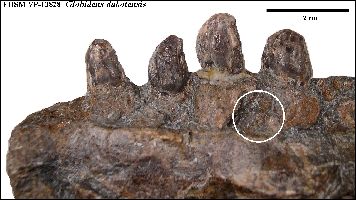 |
LEFT: Anterior teeth of FHSM VP-13828 in lingual view. White circle
indicates location of the pit formed by a replacement tooth behind and below the older
tooth. Scale bar = 2 cm. RIGHT: A shed (fallen out) tooth of Globidens
sp. from the phosphates of Morocco in Africa. The oval scar on the middle
tooth in the lower row was caused as the replacement tooth absorbed the root of this
tooth. A functional mosasaur tooth, including those
of Globidens, would normally have a long, columnar root that is solidly
attached to the surrounding bone. As the replacement tooth begins to grow, the root of the
old tooth is absorbed, allowing it to fall out when the new tooth is ready to move into
the alveolus in the jaw. |
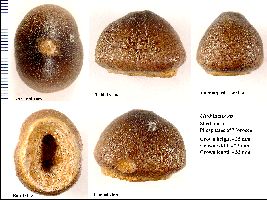 |
A review of the literature on Globidens showed that the specimen
from Alabama is considered to be the oldest in terms of geologic time (Early Campanian).
The first specimen from South Dakota (G. dakotensis) came from approximately the
same stratigraphic level in the Pierre Shale as the Kansas specimen (Middle Campanian).
Another, undescribed specimen from Texas probably falls between G. alabamaensis
and G. dakotensis in age. The latest specimen from South Dakota is apparently the
most recent. On the basis of a brief field examination of that material, Jim Martin at the
South Dakota School of Mines (personal communication, 1995) determined that the Kansas
specimen is not the same species as new new specimen. Globidens skulls
appear to be adapted to stand the stresses of a crushing-type bite and the latest Globidens
from South Dakota is even more robust in that regard than the earlier species.
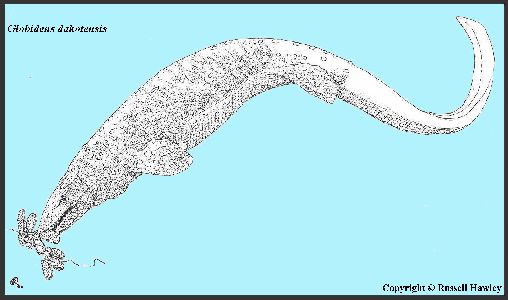 |
The Kansas Globidens was found in the Sharon Springs
member of the Pierre Shale (Middle Campanian), just below the contact with the Weskan
member. From the stratigraphic evidence, it now appears that this specimen is
approximately the same age as Globidens dakotensis. Unfortunately, because the
type specimen of G. dakotensis does not have a lower jaw, the lower jaw from
Kansas cannot be positively assigned to that or any other species. (Adapted from a pen and
ink drawing by Russell Hawley) |
 |
Since Kansas was located under the Western Interior Sea between
Alabama and Texas on the south and South Dakota to the North, it seems likely that Globidens
would have been found here also. However, even with more than 100 years of fossil
collecting in Western Kansas by such famous paleontologists as E. D. Cope, O. C.
Marsh, C.H. Sternberg, S.W. Williston, and the many others that followed, no Globidens
remains had been reported prior to 1996. |
The globular teeth of Globidens are so radically different from the
normal teeth associated with mosasaurs that it seems evident that this genus had a
completely different life style and food source. A twenty foot long mosasaur weighing a
thousand pounds or more could certainly eat whatever it wanted, and even round teeth are
capable of killing smaller prey. It is most likely, however, given the adaptations that
are apparent in the teeth and skull, that Globidens fed on hard shelled
invertebrates captured on the sea bottom. It is likely that mosasaurs such as Prognathodon with their large, conical teeth had pursued
shelled prey, such as ammonites or even turtles, for millions of years. Globidens
may have been an extreme adaptation to that end.
 |
In October, 1997, I had the opportunity to visit The Field Museum in
Chicago during the Society of Vertebrate Paleontology meeting. While there, I was allowed
the opportunity (Thanks, Bill!) to examine and photograph the type specimen of
Globidens dakotensis that had been described by Dale Russell. The two pictures below
show the underside of the skull and a comparison of the right dentary of the Kansas
specimen with the maxillary teeth of G. dakotensis. While not scientifically
significant at this point, I did make the observation that although the jaw length of both
specimens is about the same, the teeth of G. dakotensis are about 50% larger in size. I
would guess (with no way of telling for sure) that the Kansas specimen is from a slightly
smaller individual compared to the type specimen. LEFT: A ventral view of of the
skull of type specimen of Globidens dakotensis (FMNH
PR 846) in the Field Museum, Chicago, IL. |
 |
LEFT: A close-up showing the teeth of the right dentary of the
Kansas Globidens sp. ((FHSM VP-13828), above) compared with the teeth on the
premaxilla and right maxillary of the type specimen of Globidens dakotensis (FMNH
PR 846). Martin (2007) indicated that he believes the
Kansas specimen should be identified as Globidens dakotensis. |
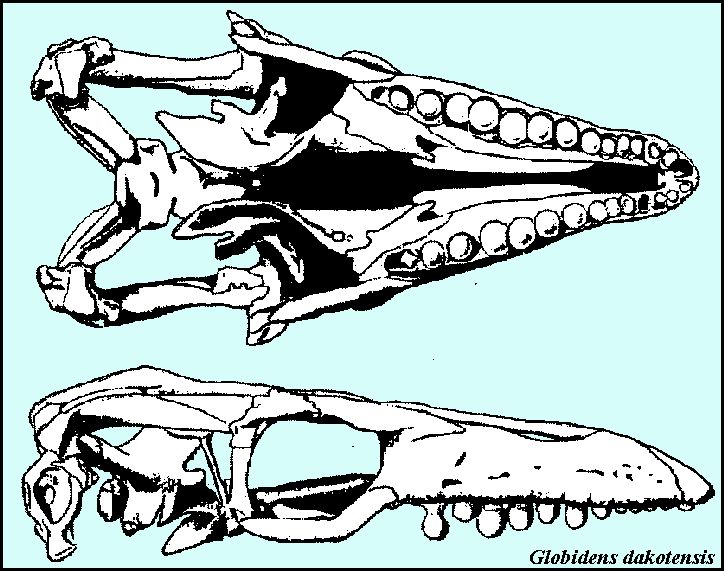 |
LEFT: Ventral and lateral views of the type specimen of Globidens
dakotensis (FMNH PR 846); drawing adapted from Russell, 1975. Skull is approximately
26 inches in length. |
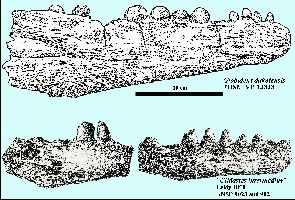 |
LEFT: A comparison between the FHSM VP-13828 (Scale bar = 10 cm) and a
composite drawing of holotype of "Clidastes intermedius Leidy 1870 (ANSP 9023,
9024) from Pickens County, Alabama (no scale); adapted from Leidy, 1873 (Plate 34, figs. 1
and 2). Note that edentulous tip of the FHSM VP-13828 dentary does not compare favorably
with the terminally located tooth on the left dentary of the type specimen of ‘Clidastes’
intermedius." The anterior portion of the jaw (ANSP 9023) is from
the left dentary and is reversed from Leidy's original figure in this composite drawing.
Drawing of FHSM VP-13828 by Russell Hawley. |
References:
Dollo, L. 1913. Globidens fraasi, mosasaurien mylodonte nouveau du
Maestrichtien (Crétacé supérieur) du Limbourg, et l'éthologie de la nutrition chez les
mosasauriens. Arch. Biol. XXVIII 1913, 609-626, pls. xxiv, xxv. (in French)
Dollo, L. 1924. Globidens alabamaensis mosasaurien Américain retrouvé dans
la Craie d'Obourg (Sénonien supérieur) du Hainaut, et les mosasauriens de la Belgique en
général. Arch. Biol. 34;167-213, pl. V.
Everhart, M.J. 2008. Rare occurrence of a Globidens sp. (Reptilia;
Mosasauridae) dentary in the Sharon Springs Member of the Pierre Shale (Middle Campanian)
of Western Kansas. p. 23-29 in Farley G. H. and Choate, J.R. (eds.), Unlocking the
Unknown; Papers Honoring Dr. Richard Zakrzewski, , Fort Hays Studies, Special Issue No. 2,
153 p., Fort Hays State University, Hays, KS.
Everhart, M. J. and P. A. Everhart. 1996. First
report of the shell crushing mosasaur, Globidens sp., from the Sharon Springs
Member of the Pierre Shale (upper Cretaceous) of Western Kansas. Kansas Academy of
Science, Transactions 15(Abstracts): 17.
Gilmore, Charles W. 1912. A new mosasauroid reptile from the Cretaceous of
Alabama, Proceedings U.S. National Museum, 40(1870): 489-484, 3 fig., pl. 39-40
(Description of Globidens alabamaensis type)
Huene, E. von. 1935. Mosasaurier-Zähne von Timor. Centralblatt fur
Mineralogie. Geologic und Palaeontologie; in Verbindung mit dens Neuen Jahrbuch fur
Mineralogie, Geologie und Palaeontologie. Stuttgart. Abt. B 10 412-416, 3 figs. (in
German)
Leidy, J. 1873. Contributions to the extinct vertebrate fauna of the western interior
territories. Rept., U.S. Geological Survey Territories (Hayden) 1:358 pp., 37 pls.
Lingham-Soliar, T. 1999. The durophagous mosasaurs (Lepidosauromorpha,
Squamata) Globidens and Carinodens from the Upper Cretaceous of Belgium
and the Netherlands. Paleontological Journal. 33(6):638-647, translated from the Russian,
Paleontologicheski Zhurnal 6:34-43.
Martin, J. E. and J. E. Fox. 2004. Molluscs in the
stomach contents of Globidens, a shell crushing mosasaur, from the Late
Cretaceous Pierre Shale, Big Bend area of the Missouri River, central South Dakota.
Geological Society of America, 2004 Rocky Mountain and Cordilleran Regions Joint Meeting,
Abstracts with Programs, 36(4):80.
Martin, J. E. 2007. A new species
of the durophagous mosasaur, Globidens (Squamata: Mosasauridae) from the Late Cretaceous
Pierre Shale Group of central South Dakota, USA. Pages 167-176 in Martin, J. E. and Parris
D. C. (eds.), The Geology and Paleontology of
the Late Cretaceous Marine Deposits of the Dakotas. Geological Society of America, Special
Paper 427.
Martin, J. E. and Fox, J. E. 2007.
Stomach contents of Globidens, a shell-crushing
mosasaur (Squamata), from the Late Cretaceous Pierre Shale Group, Big Bend area of the
Missouri River, central South Dakota. Pages 167-176 in Martin, J. E. and Parris D. C.
(eds.), The Geology and Paleontology of the Late
Cretaceous Marine Deposits of the Dakotas. Geological Society of America, Special Paper
427.
Russell, Dale A. 1975. A new species of Globidens from
South Dakota. Fieldiana Geology, 33(13): 235-256. (Field Museum of Natural History)
Saint Fond, F. 1799. Head of
the Crocodile p. 59-67 (First published history of Mosasaurus hoffmanni); from
"Historie Naturelle de la Montage de Saint-Pierre de Maestricht"; Translated
from the French by Jean-Michel Benoit.
Schulp, A.S.
2005. Feeding the mechanical mosasaur: what did Carinodens eat? Netherlands Journal
of Geosciences / Geologie en Mijnbouw, 84(3), p. 345-358.
Schulp, A. S., J.W.M. Jagt, F. Fonken. 2004. New material of the mosasaur Carinodens
belgicus from the Upper Cretaceous of the Netherlands. Journal of Vertebrate
Paleontology 24(3): 744-747.
Thurmond, J. T. 1969. Notes on mosasaurs from Texas. The Texas Journal of Science
21(1):69-79.
















